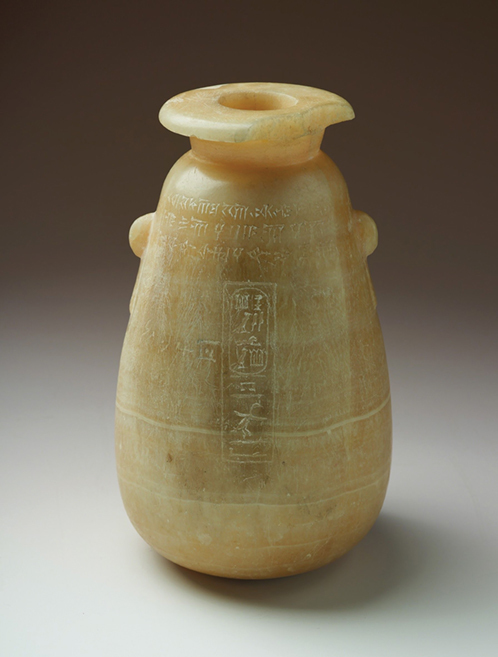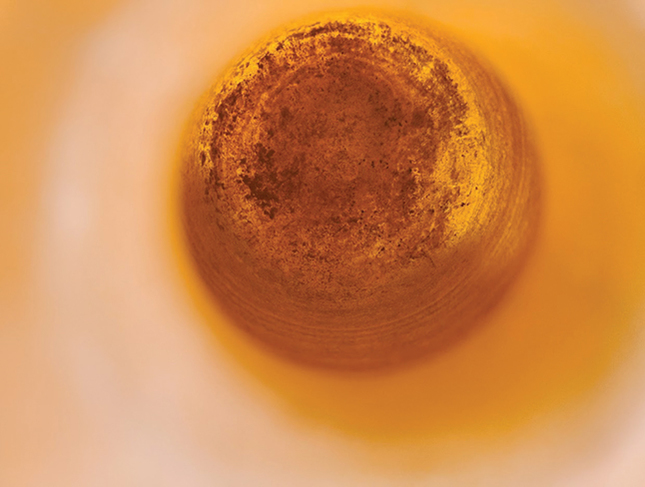
Yale Babylonian Collection, Peabody Museum of Natural History
This Egyptian stone vessel is carved with four different versions of ancient writing.
View full image

Yale Babylonian Collection, Peabody Museum of Natural History
This Egyptian stone vessel is carved with four different versions of ancient writing.
View full image

Andrew Koh
When you peer down the vessel’s throat--as in the photo above--you can see dark flecks, the residue of ancient pharmacology.
View full image

Andrew Koh
When you peer down the vessel’s throat--as in the photo above--you can see dark flecks, the residue of ancient pharmacology.
View full image
All over the ancient world, many very different cultures relied on an embedded and sophisticated knowledge of plants that could be used for healing or ritual, for sustenance or leisure. While their use was pervasive in antiquity, these plants, and with them the knowledge of their use, faded from memory. The distinctive transdisciplinary approach of the recently established Yale Ancient Pharmacology Program (YAPP) may provide keys to their rediscovery. This intriguing vessel in the Yale Peabody Museum’s renowned Babylonian Collection offers a fascinating glimpse into this rich pharmacopeic world.
The vessel is an inscribed Egyptian alabastron: a container made from stone. It dates to circa 486–465 BCE, during the reign of Great King Xerxes I, whose Achaemenid Empire stretched from Egypt and the Balkans in the west to the Indus Valley and Central Asia in the east. Xerxes, famous for his invasion of Greece in 480, is also likely the “King Ahasuerus” who features so prominently in the biblical Book of Esther. The alabastron, made of calcite, is inscribed to Xerxes quadrilingually—in Old Persian, Elamite, Akkadian, and hieroglyphic Egyptian—and it includes an addendum in demotic (i.e., simplified) Egyptian that gives the capacity of the vessel in a Persian unit of measurement: “12 kepedj-units” or about 1,200 milliliters. Its attractive appearance and inscriptions were likely what brought it to the Yale Babylonian Collection originally, but we now have an uncommon opportunity to learn much more about it.
The history of these rare inscribed alabastra is not well known, but they are connected to elite contexts; examples have been found at the Mausoleum of Halicarnassus and a Sarmatian burial mound in what is now Russia. The scholarly consensus has been that these alabastra were produced, and at least initially inscribed, in Egypt. There is less consensus about their role in ancient societies. Speculation has ranged widely from cosmetic containers to the conveyance of private messages.
Recently, analysis by YAPP determined the original contents of the alabastron shown here. Ancient vessels are often prioritized for study due to a high degree of preservation and interesting visual features, yet their most important characteristic in antiquity—their contents—usually remains unknown. This alabastron, like many ancient vessels, preserves traces of organics that were noted in ancient pharmacopeic textual records. The records are as diverse as the Papyrus Ebers—a medical catalog produced early in the Egyptian New Kingdom—and the Anicia Juliana Codex, an early Byzantine manuscript of Dioscorides’ De Materia Medica. Both were cross-referenced for this study.
When the organic residues in the alabastron were extracted, YAPP discovered an array of opiate biomarkers. The detailed formulas provided by ancient texts mirror the alabastron’s pharmacological purpose; one particular class of opiate concoction seems to be directly associated with this type of vessel. Corroborating evidence came from similar Egyptian calcite vessels.
Some of the calcite vessels the project has previously analyzed came from a relatively modest tomb in Egypt. However, a number of those vessels, much larger in size and elaborately decorated, had been found by none other than Howard Carter in the tomb of Tutankhamun. The Tutankhamun vessels showed visibletraces of a similar dark residue. This suggests a much broader horizon of shared pharmacopeic traditions across the ancient world that transcended both status and local cultural practices. We now stand at the threshold of reimagining the nature of ancient pharmacology and, ultimately, what meaning it holds for us today.
 loading
loading